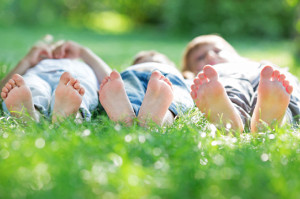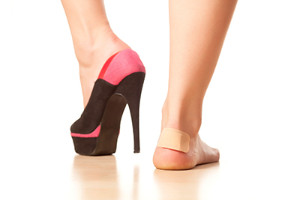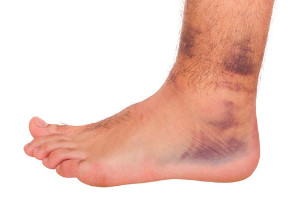Items filtered by date: November 2019
Getting Adequate Sleep May Be Linked To Preventing Running Injuries
 Research has indicated that the amount of sleep runners get may be linked to possibly preventing running injuries. Sleep helps the body to maintain strength, and may be connected to the minimization of stress the muscles and joints endure while running. Other benefits of sleeping the recommended eight hours per night may include restoring the body’s energy, recovery from possible fatigue, and enhancing one’s running performance. Getting the proper amount of sleep may be beneficial in recovering from an existing injury, as well as helping one to become more alert. Healthy sleep habits can include maintaining a consistent sleep schedule, and resting in a bedroom that is cool and comfortable. If you would like additional information about how to prevent running injuries, please consult with a podiatrist.
Research has indicated that the amount of sleep runners get may be linked to possibly preventing running injuries. Sleep helps the body to maintain strength, and may be connected to the minimization of stress the muscles and joints endure while running. Other benefits of sleeping the recommended eight hours per night may include restoring the body’s energy, recovery from possible fatigue, and enhancing one’s running performance. Getting the proper amount of sleep may be beneficial in recovering from an existing injury, as well as helping one to become more alert. Healthy sleep habits can include maintaining a consistent sleep schedule, and resting in a bedroom that is cool and comfortable. If you would like additional information about how to prevent running injuries, please consult with a podiatrist.
Exercising your feet regularly with the proper foot wear is a great way to prevent injuries. If you have any concerns about your feet, contact one of our podiatrists of Carolina Foot & Ankle. Our doctors will treat your foot and ankle needs.
How to Prevent Running Injuries
Many common running injuries are caused by overuse and overtraining. When the back of the kneecap starts wearing out and starts causing pain in your knee, this is commonly referred to as runner’s knee. Runner’s knee is a decrease in strength in your quadriceps and can occur if you’re not wearing properly fitted or supporting shoes. To prevent runner’s knee, focusing on hip strengthening is a good idea, as well as strengthening your quads to keep the kneecaps aligned.
What Are Some Causes of Running Injuries?
- One cause of a common running injury is called iliotibial band syndrome.
- Plantar fasciitis is also another common injury.
- Stress fractures can occur from overtraining, lack of calcium, or even your running style.
Best Ways to Prevent Running Injuries
- Wear footwear that fits properly and suits your running needs.
- Running shoes are the only protective gear that runners have to safeguard them from injury.
- Make a training schedule. Adding strengthening exercises as well as regular stretching can help keep you strong and limber and can lessen the possibility of injuries.
- Stretching keeps muscles limber; this will help you gain better flexibility.
If you have any questions please feel free to contact one of our offices located in Huntersville Office | 16419 Northcross Dr Suite A, Huntersville, NC 28078; Mooresvillle Office | 206 Joe Knox Avenue Suite D, Mooresville, NC 28117; and Mountain Island | 10310 Couloak Drive Suite 200, Charlotte, NC 28216 . We offer the newest diagnostic and treatment technologies for all your foot and ankle needs.
Three Types of Ankle Sprains
Research has indicated the chances of a full recovery from an ankle sprain may be increased when an aggressive role in healing is practiced after the injury occurs. This may include initially wrapping the affected ankle in an elastic bandage followed by performing gentle stretching techniques when the ankle begins to feel better. These practices may help the ankle to heal faster which can be beneficial in resuming any sporting activity. There are known to be three types of ankle sprains. Light sprains will generally heal in approximately three weeks. If the ligaments are severely stretched, recovery may last between four and six weeks. Torn ligaments are referred to as a serious ankle sprain, and the healing process can take up to three months. If you have endured an ankle sprain, it is advised that you speak to a podiatrist who can properly treat this condition.
Although ankle sprains are common, they aren’t always minor injuries. If you need your ankle injury looked at, contact one of our podiatrists from Carolina Foot & Ankle. Our doctors can provide the care you need to keep you pain-free and on your feet.
How Does an Ankle Sprain Occur?
Ankle sprains are the result of a tear in the ligaments within the ankle. These injuries may happen when you make a rapid shifting movement while your foot is planted. A less common way to sprain your ankle is when your ankle rolls inward while your foot turns outward.
What Are the Symptoms?
- Pain at the sight of the tear
- Bruising/Swelling
- Ankle area is tender to touch
- In severe cases, may hear/feel something tear
- Skin discoloration
Preventing a Sprain
- Wearing appropriate shoes for the occasion
- Stretching before exercises and sports
- Knowing your limits
Treatment of a Sprain
In many cases, the RICE method (Rest, Ice, Compression, and Elevate) is used to treat ankle sprains. However, you should see a podiatrist to see which treatment option would work best with your injury. In severe cases, surgery may be required.
It is important to ask your doctor about rehab options after you receive treatment for your injury. Stretching, strength training, and balance exercises may help the ankle heal while also preventing further injury.
If you have any questions, please feel free to contact one of our offices located in Huntersville Office | 16419 Northcross Dr Suite A, Huntersville, NC 28078; Mooresvillle Office | 206 Joe Knox Avenue Suite D, Mooresville, NC 28117; and Mountain Island | 10310 Couloak Drive Suite 200, Charlotte, NC 28216 . We offer the newest diagnostic and treatment technologies for all your foot care needs.
When Should Children Walk Barefoot?
 Many parents notice their children have flat feet. Research has indicated that the majority of babies are born flat-footed, and in most cases, it may be nothing to be concerned about. This happens as a result of bones that are still flexible. Typically, these bones will become stronger as the aging process occurs. It is important that toddlers walk barefoot as often as possible while indoors. This forces the toes to grip the floor, which generally strengthens the overall foot. When children begin to walk outside, wearing shoes that have a soft sole may be beneficial in sensing different surfaces. Additionally, it is important to ensure there is adequate room for the toes to move freely in. Laces or fasteners may help to provide the stability that is needed to keep the shoes on the feet. If you have concerns about the development of your child’s feet, it is advised that you counsel with a podiatrist who can answer any questions you may have.
Many parents notice their children have flat feet. Research has indicated that the majority of babies are born flat-footed, and in most cases, it may be nothing to be concerned about. This happens as a result of bones that are still flexible. Typically, these bones will become stronger as the aging process occurs. It is important that toddlers walk barefoot as often as possible while indoors. This forces the toes to grip the floor, which generally strengthens the overall foot. When children begin to walk outside, wearing shoes that have a soft sole may be beneficial in sensing different surfaces. Additionally, it is important to ensure there is adequate room for the toes to move freely in. Laces or fasteners may help to provide the stability that is needed to keep the shoes on the feet. If you have concerns about the development of your child’s feet, it is advised that you counsel with a podiatrist who can answer any questions you may have.
Making sure that your children maintain good foot health is very important as they grow. If you have any questions, contact one of our podiatrists of Carolina Foot & Ankle. Our doctors can provide the care you need to keep you pain-free and on your feet.
Keeping Children's Feet Healthy
Having healthy feet during childhood can help prevent medical problems later in life, namely in the back and legs. As children grow, their feet require different types of care. Here are some things to consider...
Although babies do not walk yet, it is still very important to take care of their feet.
Avoid putting tight shoes or socks on his or her feet.
Allow the baby to stretch and kick his or her feet to feel comfortable.
As a toddler, kids are now on the move and begin to develop differently. At this age, toddlers are getting a feel for walking, so don’t be alarmed if your toddler is unsteady or ‘walks funny’.
As your child gets older, it is important to teach them how to take care of their feet.
Show them proper hygiene to prevent infections such as fungus.
Be watchful for any pain or injury.
Have all injuries checked by a doctor as soon as possible.
Comfortable, protective shoes should always be worn, especially at play.
If you have any questions please feel free to contact one of our offices located in Huntersville Office | 16419 Northcross Dr Suite A, Huntersville, NC 28078; Mooresvillle Office | 206 Joe Knox Avenue Suite D, Mooresville, NC 28117; and Mountain Island | 10310 Couloak Drive Suite 200, Charlotte, NC 28216 . We offer the newest diagnostic and treatment technologies for all your foot and ankle needs.
The Benefits of Strengthening the Ankles
 Research has indicated that the biomechanics of the ankle may be compromised if high heels are frequently worn. They may affect balance and strength, and this can allow falls to occur. If the desire to wear high heels is strong, it may be beneficial to alternate wearing these types of shoes with shoes that have a lower and wider heel. It may help to perform specific stretches while sitting, and this may aid in restoring strength in the ankle. Additionally, the ankle joints may become more stable, which can help to reduce the risk of injury. Heel lifts are an effective stretch for the entire foot. This is done by standing and slowly lifting the heels up and down, and then alternating feet. If you would like additional information about how to strengthen your feet from frequently wearing high heels, please consult with a podiatrist.
Research has indicated that the biomechanics of the ankle may be compromised if high heels are frequently worn. They may affect balance and strength, and this can allow falls to occur. If the desire to wear high heels is strong, it may be beneficial to alternate wearing these types of shoes with shoes that have a lower and wider heel. It may help to perform specific stretches while sitting, and this may aid in restoring strength in the ankle. Additionally, the ankle joints may become more stable, which can help to reduce the risk of injury. Heel lifts are an effective stretch for the entire foot. This is done by standing and slowly lifting the heels up and down, and then alternating feet. If you would like additional information about how to strengthen your feet from frequently wearing high heels, please consult with a podiatrist.
High heels have a history of causing foot and ankle problems. If you have any concerns about your feet or ankles, contact one of our podiatrists from Carolina Foot & Ankle. Our doctors can provide the care you need to keep you pain-free and on your feet.
Effects of High Heels on the Feet
High heels are popular shoes among women because of their many styles and societal appeal. Despite this, high heels can still cause many health problems if worn too frequently.
Which Parts of My Body Will Be Affected by High Heels?
- Ankle Joints
- Achilles Tendon – May shorten and stiffen with prolonged wear
- Balls of the Feet
- Knees – Heels cause the knees to bend constantly, creating stress on them
- Back – They decrease the spine’s ability to absorb shock, which may lead to back pain. The vertebrae of the lower back may compress.
What Kinds of Foot Problems Can Develop from Wearing High Heels?
- Corns
- Calluses
- Hammertoe
- Bunions
- Morton’s Neuroma
- Plantar Fasciitis
How Can I Still Wear High Heels and Maintain Foot Health?
If you want to wear high heeled shoes, make sure that you are not wearing them every day, as this will help prevent long term physical problems. Try wearing thicker heels as opposed to stilettos to distribute weight more evenly across the feet. Always make sure you are wearing the proper shoes for the right occasion, such as sneakers for exercising. If you walk to work, try carrying your heels with you and changing into them once you arrive at work. Adding inserts to your heels can help cushion your feet and absorb shock. Full foot inserts or metatarsal pads are available.
If you have any questions please feel free to contact one of our offices located in Huntersville Office | 16419 Northcross Dr Suite A, Huntersville, NC 28078; Mooresvillle Office | 206 Joe Knox Avenue Suite D, Mooresville, NC 28117; and Mountain Island | 10310 Couloak Drive Suite 200, Charlotte, NC 28216 . We offer the newest diagnostic and treatment technologies for all your foot and ankle needs.


